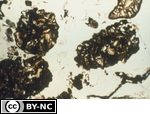Download Image
5.40 MB

ID # 174
Fecal pellets of Tipulid larvaeFrom the Soil Micromorphology Slide Collection
STEM Standard addressed: ESS2E - Biogeology
Appropriate Grade Level(s)
- College-level
- Classroom Lectures
- Laboratory Activities
- Soil Microbiology
Micromorphological description of slide: Phyto-humigranic fabric--loose random arrangement of fine meso and coarse micro fecal pellets of Collembola (springtails); organic composition with partially decomposed meso and macro plant fragments.
Data for the horizon
Horizon sampled: LFH
Depth sampled: 8-0 cm
Physical and chemical data available: L: pH = 6.1, OC = 35.5 N = 1 .47%. F: pH = 5.6, OC = 35.0%, N = 1 .56%. H: pH = 4.9, OC = 20.3%, N = 0.83%.
Macromorphological description of horizon: L (8-5 cm): Leaf litter; undecomposed and semi decomposed spruce needles and aspen leaves. F (5-1 cm): Some decomposed leaves, needles, mixed with grass roots; loose to matted, numerous fungi; abundant fine and very fine random and plentiful, medium random roots. H (I -O cm): Decomposed fibrous to matted organic matter; abundant, fine and very fine random and plentiful, medium roots; clear, smooth boundary.
Micromorphological description of horizon (Brewer, 1 976): The F layer is dominantly phyto-humigranic fabric with partially decomposed plant fragments and humigranic units of variable size. The H layer has a few mullgranic units and orthogranic units are more prominent as well. Phytogranic units diminish in importance. Fungal hyphae dominate throughout. All units are largely of the humigranic type but develop 8 weak mull character near the lower boundary.
Data for thin section
Preparation of sample: Air dry
Impregnating medium: Epoxy
Thickness of section: 30 µm
Orientation of section: Vertical
Soil Classification
U.S.: Typic Cryoboralf
F.A.O.: Albic Luvisol
Canada: Orthic Gray Luvisol
Elevation: 700 m above sea level
Topography and hill slope position: Level to undulating upper slope Parent material: Till
Soil climatic data and/or soil water balance: Subhumid moisture regime and cold soil temperature class
Vegetation: Boreal forest; Populus tremuloides and Picea qlauca
Data for the horizon
Horizon sampled: LFH
Depth sampled: 8-0 cm
Physical and chemical data available: L: pH = 6.1, OC = 35.5 N = 1 .47%. F: pH = 5.6, OC = 35.0%, N = 1 .56%. H: pH = 4.9, OC = 20.3%, N = 0.83%.
Macromorphological description of horizon: L (8-5 cm): Leaf litter; undecomposed and semi decomposed spruce needles and aspen leaves. F (5-1 cm): Some decomposed leaves, needles, mixed with grass roots; loose to matted, numerous fungi; abundant fine and very fine random and plentiful, medium random roots. H (I -O cm): Decomposed fibrous to matted organic matter; abundant, fine and very fine random and plentiful, medium roots; clear, smooth boundary.
Micromorphological description of horizon (Brewer, 1 976): The F layer is dominantly phyto-humigranic fabric with partially decomposed plant fragments and humigranic units of variable size. The H layer has a few mullgranic units and orthogranic units are more prominent as well. Phytogranic units diminish in importance. Fungal hyphae dominate throughout. All units are largely of the humigranic type but develop 8 weak mull character near the lower boundary.
Data for thin section
Preparation of sample: Air dry
Impregnating medium: Epoxy
Thickness of section: 30 µm
Orientation of section: Vertical
Soil Classification
U.S.: Typic Cryoboralf
F.A.O.: Albic Luvisol
Canada: Orthic Gray Luvisol
Elevation: 700 m above sea level
Topography and hill slope position: Level to undulating upper slope Parent material: Till
Soil climatic data and/or soil water balance: Subhumid moisture regime and cold soil temperature class
Vegetation: Boreal forest; Populus tremuloides and Picea qlauca
Method
Data for 35-mm slide
Frame length: 3.5 mm
Light mode: Plane polarized
Frame length: 3.5 mm
Light mode: Plane polarized
References
Brewer, R. 1 976. Fabric and mineral analysis of soil, Krieger Publ.Co., Melbourne, FL. Howitt, R.W. and S. Pawluk. 1 985. The genesis of a Gray Luvisol within the Boreal Forest Region.
1 . Static pedology. Can. J. of Soil Sci. 65:1-9. Pawluk, S. 1 985. Faunal influences on soil structure. Quest. Ent. 21 :473-496. (pub'. Dept. of Entomology, Univ. of Alberta, Canada, T6G 2E3)
Slide BF30. Soil Science Society of America, 1993. A Reference Slide Collection for Soil Micromorphology. SSSA, Madison, WI.
1 . Static pedology. Can. J. of Soil Sci. 65:1-9. Pawluk, S. 1 985. Faunal influences on soil structure. Quest. Ent. 21 :473-496. (pub'. Dept. of Entomology, Univ. of Alberta, Canada, T6G 2E3)
Slide BF30. Soil Science Society of America, 1993. A Reference Slide Collection for Soil Micromorphology. SSSA, Madison, WI.
Peer Review: Yes
Credit this item to: SSSAMedia Date: 1993-01-01
Provided By: (SSSA) Soil Science Society of America
Latitude: 53.10999
Longitude: -114.47139479999998
Author(s)/Creator(s)
-
* Soil Science Society of America
SSSA
Submitted By: (SSSA) Soil Science Society of America
Keywords
- Biological Features
- LFH Horizon
- micromorphology
- Tipulid larvae
Comments
Please login to submit a comment.
Log In to your account
Already a member, certified, or existing customer?*
* Cookies must be accepted to log in.
Not sure if you have an account?
Check Your Email
Join Us!
Connect with members and access the information you need.
Learn more.
Ready to Join?
If you have an account, login on the left. Not sure if you have an account or need to create one? Check your email with the link above. We look forward to welcoming you.